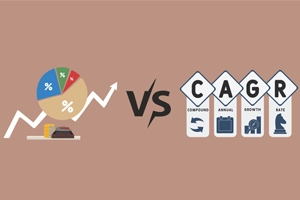
Understanding investment performance is critical for making informed financial decisions. For Indian investors, particularly those navigating the complex mutual fund landscape, the metrics XIRR vs CAGR are invaluable tools. These measures offer insights into returns but differ in their approach and application, making them suitable for specific investment scenarios. Let us take a look at important aspects such as what is CAGR, what is XIRR, the differences between these metrics, their relevance to SIP investments, and their limitations, to ensure that you know exactly what to use when measuring the performance of your portfolio.
What Is CAGR?
CAGR (Compound Annual Growth Rate) is a metric that calculates the average annual growth rate of an investment over a specified period, assuming steady growth. It is ideal for evaluating lump sum investments or comparing investments held for the same duration. However, it does not account for intermediate cashflows, making it less suitable for investments with irregular contributions or withdrawals.
The formula for CAGR is:
CAGR = (Final Value of Investment/ Initial Value of Investment) ^1/n – 1
where n is the investment period in years
CAGR provides a clear picture of returns, especially for investments like market indices or fixed-term equity funds.
What Is XIRR?
XIRR (Extended Internal Rate of Return) calculates the annualised returns on investments that involve irregular cashflows, such as multiple SIPs or withdrawals. By factoring in the exact dates and amounts of cashflows, XIRR provides a more accurate reflection of returns for such scenarios.
So, what is XIRR in mutual fund investments? It is a preferred metric for calculating returns on portfolios with varying contributions over time. Similarly, what is XIRR in SIP is a common question among investors who rely on systematic investment plans but experience missed or paused contributions.
XIRR is calculated using specialised software, financial calculators, or MS Excel. The function considers:
- Dates of cashflows (investments and withdrawals)
- Corresponding cash amounts
- The assumption of reinvestment at the same rate
For investments involving multiple irregular cashflows, what is XIRR return becomes the go-to question for accurate performance assessment.
XIRR vs CAGR – Major Differences
When comparing CAGR and XIRR, there are distinct differences in their assumptions, applicability, and accuracy. CAGR assumes a single initial investment value and a final value, making it ideal for assessing lump sum investments and market indices. In contrast, XIRR accounts for irregular cashflows occurring at various points, making it more suited for scenarios such as SIPs, real estate investments, and private equity. Timing sensitivity is another critical factor. CAGR ignores the timing of cashflows, which can oversimplify the analysis, while XIRR considers the exact dates of transactions, providing a more nuanced evaluation of investment performance. Regarding accuracy, CAGR is accurate for single cashflows but falls short when dealing with irregular investments. XIRR, on the other hand, excels in such scenarios, offering higher precision. In terms of application, CAGR is best for comparing investments over fixed periods, whereas XIRR shines in evaluating portfolios with multiple transactions and varying cashflow patterns. Understanding these differences allows investors to choose the right metric based on the nature of their investments, ensuring informed decision-making.
CAGR vs XIRR – Which is right for SIP?
When evaluating CAGR vs XIRR for SIP, the suitability of each metric depends on the investment scenario.
- CAGR:
- Ideal for analysing returns from lump sum investments.
- Useful for comparing different investments over similar time horizons.
- Simplifies interpretation but ignores interim cashflows.
- XIRR:
- Essential for SIPs with irregular cashflows or pauses.
- Reflects the true annualised return by accounting for varying contributions and withdrawals.
- Provides a granular view, especially for portfolios with diverse transactions.
For example, if an investor has multiple SIPs running simultaneously, what is XIRR return becomes the relevant metric for assessing overall portfolio performance.
Limitations to note
Despite their utility in evaluating investments, both CAGR and XIRR come with certain limitations. CAGR operates on simplistic assumptions, ignoring intermediate cashflows, which makes it less effective for scenarios beyond lump sum investments. Its tendency to smooth out year-to-year volatility can obscure short-term fluctuations, potentially misleading investors. Additionally, its inflexibility stems from assuming a fixed investment period, rendering it unsuitable for dynamic or irregular investment patterns.
On the other hand, XIRR’s calculations are more complex, requiring detailed inputs and tools like MS Excel or specialised financial calculators. It also operates under the assumption that cashflows can be reinvested at the same rate, which might not always reflect reality. Furthermore, XIRR is highly sensitive to errors—minor mistakes in dates or cashflow entries can significantly skew results.
While these limitations highlight areas of caution, both metrics remain invaluable when used in appropriate contexts, offering investors critical insights for informed decision-making.
Conclusion
Choosing between XIRR vs CAGR depends on the nature of your investments. For lump sum investments or comparing market indices, what is CAGR becomes a relevant question. On the other hand, for portfolios involving SIPs or irregular cashflows, understanding what is XIRR in SIP or what is XIRR in mutual fund investments is crucial. While both metrics have their pros and cons, using them appropriately allows for a deeper understanding of investment performance. Tools like a XIRR vs CAGR calculator can help simplify the process and ensure informed decision-making.
By mastering these metrics, investors can better navigate the complexities of the Indian financial market, optimising their portfolios for long-term success.
An investor education initiative by Edelweiss Mutual Fund
All Mutual Fund Investors have to go through a one-time KYC process. Investors should deal only with Registered Mutual Fund (RMF). For more info on KYC, RMF and procedure to lodge/redress any complaints, visit - https://www.edelweissmf.com/kyc-norms
MUTUAL FUND INVESTMENTS ARE SUBJECT TO MARKET RISKS. READ ALL SCHEME RELATED DOCUMENTS CAREFULLY
Trending Articles
MUTUAL FUND INVESTMENTS ARE SUBJECT TO MARKET RISKS, READ ALL SCHEME RELATED DOCUMENTS CAREFULLY.















